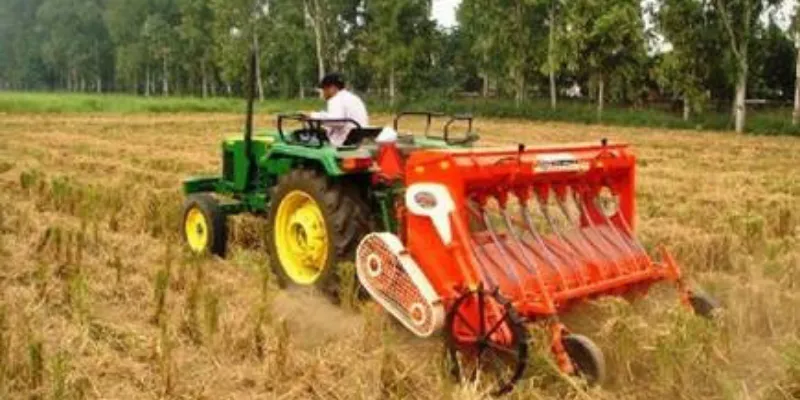How CII Foundation, ONGC Foundation are working with farmers to fight toxic stubble burning
Stubble burning is a contributor to air pollution levels, but the age-old practice continues as farmers have no viable options.
Every year, farmers across Uttar Pradesh, Haryana, Punjab, and Rajasthan set fire to the paddy harvest residue in their fields to prepare the soil for the sowing of the wheat crop. The controversial practice, called ‘stubble burning,’ follows the 'combine harvesting' method, where the straws are not cut close enough to the soil.
With pressure to sow in time for a full yield, most farmers resort to burning the residue, as they believe it is the quickest way to clear the soil. It is estimated that 47 million tonnes of rice straw are produced every year in these four states. Of this, 80 percent is burnt in the field.
However, one of the serious fallouts of this practice is that it is one of the contributors to the rising air pollution in the NCR area. A 2016 study by IIT-Kharagpur showed that stubble burning caused 26 percent of the PM 2.5 pollution in Delhi. It is believed that PM 2.5 air pollution resulted in 54,000 deaths in Delhi in 2019, and pollution levels reached almost 6X more than the prescribed World Health Organisation limits.
These findings were part of a Greenpeace Southeast Asia analysis of IQAir data. The deteriorating air quality has also exacerbated the COVID-19 pandemic with a study published in Cardiovascular Research, an international journal of the European Society of Cardiology, linking air pollution to 15 percent of the world’s COVID-19 deaths.

The Happy Seeders machine remove crop residue from the soil and mulches the same, thereby eliminating the need to burn the stubble.
Various organisations have been working with farmers to find alternative solutions to stubble burning. The Confederation of Indian Industry (CII) Foundation has partnered with the Oil and Natural Gas Corporation (ONGC) Foundation to conduct a Residue Management Initiative in five villages in Sirsa, Haryana. The project was rolled out in October 2019 and will continue till March 2021.
Explaining the impact the programme has had, Kiran DM, CEO, , says,
“CII’s partnership with ONGC Foundaion to promote grassroots solutions for farm stubble burning in Punjab and Haryana is a first-of-its-kind endeavour. As part of this initiative, farmers from two villages in Ludhiana, Punjab, were supported in 2018, and five villages in Sirsa, Haryana, in 2019 and 2020. Now, most farmers in the area have given up stubble burning and are opting for improved eco-friendly methods of farm residue management.”
Key challenges
One of the key findings, when initiating the project, was that many of the farmers said they were unaware that stubble burning was causing pollution and harming the environment. However, they said that they had little choice as an alternative and affordable technology was not available. They also said they were unaware of modern farming techniques that were more sustainable.
As part of the initiative, the CII Foundation worked with the farmers to identify potential solutions that were sustainable and would work in the farmers’ interests. Team members visited the farmers, held meetings, created awareness about alternative techniques, and eventually gained their trust.
One of the first steps was to create a machinery tool bank at the cluster level with the support of the local panchayat and farmers, who were open from the beginning to incorporate the necessary changes. This tool bank helped fill the gap for farm machinery required for in-situ (mulching/mixing of straw in the soil) and ex-situ (baling out) operations by farmers.
A donation of 13 farm machine tools was made to the Gidranwali Agriculture Society in Sirsa to start the community tool bank. Farmers from the project villages were also encouraged to rent out these machines to try out mechanised straw management.
A series of training sessions were conducted in collaboration with the scientists at the Haryana Agriculture University, Hisar, Krishi Vigyan Kendra (KVK), district agriculture department, and other progressive farmers.
Volunteers and leaders in the village were encouraged to keep the conversations around the harmful impact of stubble burning ongoing while a point-of-contact was assigned in each village for real-time feedback from the farmers.
Moreover, volunteers were assigned door-to-door interactions to arrange machine bookings for farmers, organise village meetings, and collect data from the ground. The teams also monitored the adoption of improved straw management practices by farmers.
Harvesting benefits
The project has already seen significant adoption in the villages. Among the farmers who have benefitted is Chetan Das Mehta in Gidranwali, Haryana. Mehta — who also works as a shopkeeper — was one of the earliest adopters of the new sustainable practices.
“I always wanted to use more sustainable practices, but could not afford the machinery and had no local support. With the CII Foundation’s help, I am now using a baler for managing crop residue and the Mitra Kit (the use of crop-friendly insects for organic farming) in my field. I have seen a lot of benefits since I started using these methods.”
The impact of the initiative has been significant in the five villages. Prior to the project, only 25 percent of the land was not being burnt. Today, 97 percent of the stubble burning has been stopped, with over 8,366 tonnes of straw saved from burning.
Kiran says the impact of mitigating air pollution, carbon sequestration, and promoting water-saving and regenerative agriculture among farmers were substantial.
Edited by Suman Singh







